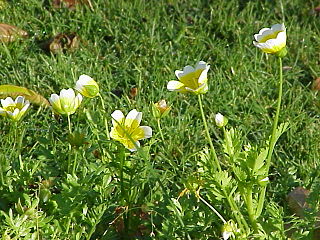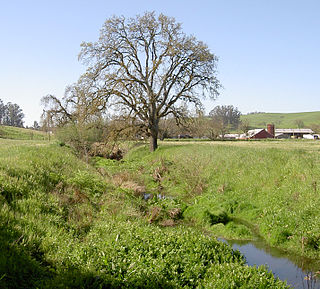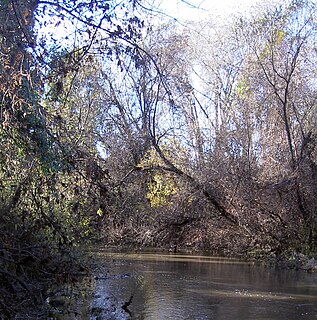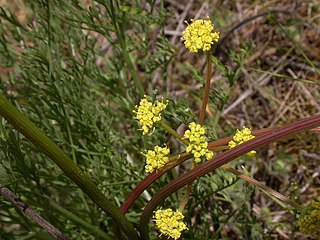
Sonoma County is a county in the U.S. state of California. As of the 2010 United States Census, its population was 483,878. Its county seat and largest city is Santa Rosa. It is to the north of Marin County and the south of Mendocino County. It is west of Napa County and Lake County.

The California tiger salamander is a vulnerable amphibian native to California. It is a mole salamander. Previously considered to be a subspecies of the tiger salamander, the California tiger salamander was recently designated a separate species again. The California tiger salamander distinct population segment (DPS) in Sonoma County and the Santa Barbara County DPS are listed as federally endangered, while the Central California DPS is listed as federally threatened. The Sonoma County, south San Joaquin, and the Santa Barbara County DPS have diverged from the rest of the California tiger salamander populations for over one million years, since the Pleistocene and they may warrant status as separate species.

Vernal pools, also called vernal ponds or ephemeral pools, are seasonal pools of water that provide habitat for distinctive plants and animals. They are considered to be a distinctive type of wetland usually devoid of fish, and thus allow the safe development of natal amphibian and insect species unable to withstand competition or predation by fish. Certain tropical fish lineages have however adapted to this habitat specifically.

Limnanthes douglasii is a species of annual flowering plant in the family Limnanthaceae (meadowfoam) commonly known as Douglas' meadowfoam or poached egg plant. It is native to California and Oregon, where it grows in wet, grassy habitat, such as vernal pools and spring meadows. It can grow in poorly drained clay soils. The plant was collected by the Scottish explorer and botanist David Douglas, who worked on the west coast of America in the 1820s.

The Limnanthaceae are a small family of annual herbs occurring throughout temperate North America. There are eight species and nineteen taxa currently recognized. Members of this family are prominent in vernal pool communities of California. Some taxa have been domesticated for use as an oil seed crop. Some members are listed as threatened or endangered and have been the focus of disputes over development plans

The Petaluma River is a river in the California counties of Sonoma and Marin that becomes a tidal slough for the majority of its length. The headwaters are in the area southwest of Cotati. The flow is generally southward through Petaluma's old town, where the waterway becomes navigable, and then flows another 10 mi (16 km) through tidal marshes before emptying into the northwest corner of San Pablo Bay.

Limnanthes alba is a species of flowering plant in the meadowfoam family known by the common name white meadowfoam. It is native to California and Oregon, where it grows in wet grassy habitat, such as vernal pools and moist spots in woodlands. It generally grows in poorly drained soils. It is an annual herb producing an erect or decumbent stem up to about 30 centimeters long. The leaves divided into several lobed or unlobed leaflets. The flower is cup-shaped with white petals 1 to 1.5 centimeters long.

Limnanthes, the type genus of the family Limnanthaceae, consists of annual herbaceous plants commonly known as the meadowfoams. The seven species are all native to coastal and adjoining regions of western North America, where they typically grow in marshy habitats, such as the margins of vernal pools. Some are endemic to California

The Laguna de Santa Rosa is a 22-mile-long (35 km) wetland complex that drains a 254-square-mile (660 km2) watershed encompassing most of the Santa Rosa Plain in Sonoma County, California, United States.

Washoe Creek is a perennial stream located in Sonoma County, California. It is about 2 mi (3 km) long and discharges to the Laguna de Santa Rosa.

Americano Creek is a 7.5-mile (12 km) long westward-flowing stream in the California counties of Sonoma and Marin. It flows into the Estero Americano, a 9.2 mi (15 km) long estuary, and thence to the Pacific Ocean. This article covers both watercourses.

Lilium pardalinum subsp. pitkinense, the Pitkin Marsh lily, is an endangered perennial herb of the family Liliaceae that is endemic to certain wetland areas in the northern California Coast Ranges of Sonoma County, California, United States. It is a subspecies of Lilium pardalinum.

Mark West Creek is a 29.9-mile-long (48.1 km) stream that rises in the Mayacamas Mountains of Sonoma County, California, United States. Tributaries of Mark West Creek include Porter Creek and Hummingbird Creek, both of which originate in the same mountain range. Discharge waters of Mark West Creek reach the Russian River after a confluence with the Laguna de Santa Rosa. The Community Clean Water Institute has developed a program for monitoring pollutants in Mark West Creek.
Blennosperma bakeri is a rare species of flowering plant in the daisy family known by the common names Baker's stickyseed and Sonoma sunshine.

Limnanthes floccosa, or woolly meadowfoam, is a species of meadowfoam found in Northern California and Southern Oregon, in the United States. Most of the subspecies have highly restricted distributions and are listed as critical or endangered.

Limnanthes bakeri is a rare species of meadowfoam known by the common name Baker's meadowfoam. It is endemic to Mendocino County, California, where it is known from only about 20 occurrences in the vicinity of Willits. It is a plant of wet, grassy habitat such as vernal pools and marshy spring meadows.
Limnanthes montana is a species of meadowfoam known by the common name mountain meadowfoam. It is endemic to the Sierra Nevada foothills of California, where it grows in wet, grassy habitat such as marshy spring meadows.
Limnanthes striata was formerly a species of meadowfoam known by the common name foothill meadowfoam. It has recently been subsumed into the species Limnanthes douglasii in both the Jepson Manual and the Flora of North America. This plant is endemic to California, where it is known from the Sierra Nevada foothills and the southern Klamath Mountains. It grows in wet, grassy habitat, carpeting the edges of vernal pools and ephemeral creeks.

Lomatium cookii is a rare species of flowering plant in the carrot family known by the common names Cook's lomatium and agate desertparsley. It is endemic to Oregon in the United States, where it grows in only two valleys. It is a federally listed endangered species.


















